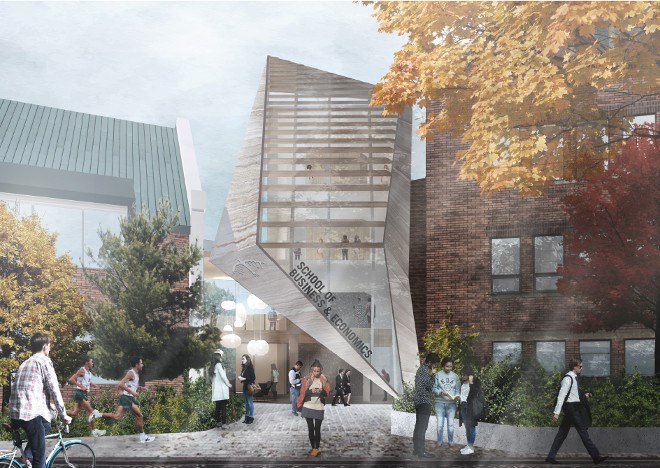When Algoma University announced in July it was establishing a School of Business and Economics, faculty members were unprepared for just how popular its new programming would be.
During the first intake of students this past September, executive director Nadine Landon was hopeful to enrol 20 post-graduate students and 12 more studying their Bachelor of Business Administration (BBA) degree. But the school very quickly blew past those expectations.
More than 100 post-grads and 28 BBA students are now enrolled at the school’s Sault Ste. Marie and Brampton campuses.
“So we're dealing with a much larger intake and everything that goes along with being prepared for that large intake: student services, physical space, faculty, classrooms,” Landon said. “We hadn't anticipated the numbers we received.”
But for the university, which has offered business studies as a pathway since 2010, formalizing its popular business programming is the culmination of a long-term vision.
Cathy Denomme, director of the School of Business and Economics, said the move gives the business school more self-direction, enabling it to introduce new programs and provide students with greater experiential learning opportunities.
“It’s what every faculty would dream of doing,” Denomme said. “It’s kind of like a rite of passage – if you have good, solid programming, then you can become a school of business and economics.”
The university is also offering a program that simultaneously earns Indigenous students their Certified Aboriginal Financial Manager designation and the Advanced Certificate in Accounting and Finance credential, a program that’s jointly offered by the Aboriginal Financial Officers Association Canada and the Chartered Professional Accountants Canada.
Or students can earn an Interdisciplinary Certificate in Indigenous Public Administration, which is a result of discussions with Algoma’s Anishnaabe Initiatives Division and the political science department to create a one-year management certificate for Indigenous learners who will be working on reserve.
“We’re working with them for their needs,” Landon said. “This is something (the Indigenous communities) have asked for.”
The school will also be fostering closer ties with industry. This January, the university will launch its first continuing education training session to 250 employees of the Algoma Steel plant.
Eventually, Denomme hopes to establish an entire suite of business-related programming, starting with English as a Second Language (ESL) all the way up to a Master’s of Business Administration (MBA) degree.
It’s not hard to see why. Algoma’s business courses are already some of its most popular programming. Roughly 30 per cent of the student population at the main Sault campus is comprised of business students, and graduates are in high demand.
Denomme said employers are impressed by how well prepared the graduates are; in particular, they appreciate their critical thinking skills.
“Our students start getting jobs in their fourth year, and by the time they graduate, I would say 80 per cent of them are employed,” said Denomme, noting the rest typically find work within a few months.
Though there are always some graduates who leave the community for work, more than 50 per cent decide to make the Sault their permanent home, she added, including international students who come to Algoma for the small class sizes and stay for the Northern Ontario lifestyle.
With all the new programming, the university will also need more space. The Sault campus is expected to grow by 5,000 square feet, while the Brampton campus will add an additional 6,000 square feet to existing space.
Denomme said the school is still in the early stages of the construction process. Lebel & Bouliane architecture firm has drawn up schematic renderings that depict what the space might look like. Integrating into the existing Wishart Library, the space will feature natural Northern materials such as limestone, wood and glass to reflect the school’s geography and surroundings.
In the Sault, with faculty scattered across campus, the new space will provide enough office space to house the faculty together, and give students a central place to gather.
“It’ll give a space for students that will be theirs, and the Wishart Library is going to be part of whatever that looks like,” Denomme said. “So our students will have a home.”
The university has recently launched a fundraising campaign to raise the capital required for the expansion, but the job still has to go out to tender, and no timeline has been determined for that yet.
It’s likely that work on the Brampton campus will start first, since that’s where the biggest growth is anticipated, Denomme said, and the goal is to have the expansion there completed by April.




